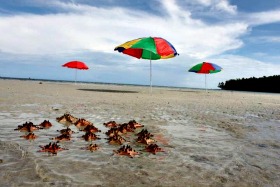A Glimpse of Ambulon Beach, Biodiversity Park
Dateline: Vincenzo Sagun, Zamboanga del Sur - this little town is so blessed by nature, with the vastness of the sea surrounding it, marine resources also abound contributing much to the economy of the place.
Mayor Edilberto Adlaon said Vincenzo Sagun municipal waters account for 30,185 hectares, far bigger than its land area which is only 6,518 hectares. No wonder they take pride in having fine white beaches, crystal clear waters, diving sites and coral formations proclaimed by divers/tourists as world-class.
From the town proper, it takes only 15 minutes to reach a quiet beach resort, Ambulon Beach with white sand and clear blue waters, frequented by locals and people from nearby municipalities on weekends and holidays. Cottages are very affordable at P100, P150 and P500.
You could bask on the sandy shore, collect starfish and other kinds of shells and enjoy swimming with family and friends. It’s a great place to unwind and forget all the cares of this life.
Being rich in marine resources, the local government through the initiative of Mayor Edilberto Adlaon established the Josefina H. Cerilles State College, Vincenzo Sagun Campus Biodiversity Park having opened a Bachelor of Science in Fisheries course. The park was established in November 2011.
Operational for quite some time now, the park serves as a natural conservation site for mangroves. It is spread over an area of over five hectares on flat wetlands. It is an excellent opportunity for the students to start discovering and appreciating the beauty and diversity of the mangrove trees, sea grass beds and blue-green waters in the area, Adlaon said.
Municipal Planning and Development Coordinator Meriline Locson said the LGU’s aim in establishing the park is to let students appreciate the significant role of mangrove trees, sea grasses, and corals in the ecosystem.

Bamboo Bridge
A bamboo bridge about 200 meters long was constructed connecting the cottage on the coast to provide students and visitors a good vantage point of the mangrove plantation. The LGU provided the funds for the purchase of bamboo while students offered their manpower to finish the bridge.
Mangrove Forests
Ms. Locson said mangroves protected the coastal areas from the devastating impact of the 1976 tsunami that claimed hundreds of lives in the province.
“Without these mangrove trees, I believe many homes would have been destroyed and hundreds buried in the shores during the tsunami in 1976 that ravaged the coastlines,” Locson said. “We thanked God that mangroves thrive in their habitat,” she added.
The lady MPDC said that the 24-year old trees which are remnants of the tsunami were preserved to be a part of the park and for the students to remember the sad event that happened and to encourage them to preserve the park.
With the locals’ active participation in mangrove preservation and conservation, mangroves are now thickly growing and surrounding the shorelines of barangay Ambulon.
Locson said they look forward to have 26 species of mangroves in the country grown in the park and be part of the students’ learning experience.
Blue Crabs
During low tide, blue crabs ((Callinectes sapidus) can also be found in the park. “We are preserving this species, in fact we have drafted an ordinance prohibiting the residents to harvest the blue crabs being in danger of extinction,” Locson said. (JPA/ALT/Gideon C. Corgue/PIA9-Zambosur)


